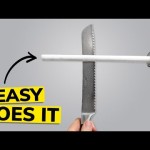Sharpening knives is an important part of kitchen maintenance, and polishing them with compound is a great way to keep them looking their best. Compound is a type of abrasive material that can be used to buff and polish metal surfaces. In this guide, we’ll discuss the basics of polishing knives with compound, including the types of compound available, the tools you’ll need, and the steps involved in the process. With the right knowledge and supplies, you can easily keep your knives looking sharp and shiny.
How do you use polishing compound for knives
Polishing compound is a great way to keep your knives looking sharp and shiny. It can be used to remove scratches, dullness, and tarnish from the blade. It is also a great way to protect the blade from rust and corrosion. Here is a step-by-step guide on how to use polishing compound for knives.
Step 1: Prepare the Knife
Before you begin polishing your knife, you need to make sure it is clean and free of any dirt or debris. Use a soft cloth to wipe down the blade and handle. If there are any stubborn spots, use a mild soap and water to remove them.
Step 2: Apply the Polishing Compound
Once the knife is clean, you can begin applying the polishing compound. Use a soft cloth to apply a small amount of the compound to the blade. Make sure to cover the entire blade, including the handle. You can also use a soft brush to help spread the compound evenly.
Step 3: Buff the Knife
Once the polishing compound is applied, you can begin buffing the knife. Use a soft cloth or a buffing wheel to buff the blade in a circular motion. Make sure to buff the entire blade, including the handle. You can also use a soft brush to help spread the compound evenly.
Step 4: Rinse and Dry the Knife
Once you have finished buffing the knife, you need to rinse it off with warm water. Use a soft cloth to wipe down the blade and handle. Make sure to remove any excess polishing compound. Once the knife is clean, you can dry it off with a soft cloth.
Step 5: Inspect the Knife
Once the knife is dry, you can inspect it to make sure it is free of scratches and tarnish. If there are any stubborn spots, you can use a soft cloth to buff them out. Once you are satisfied with the results, you can store the knife in a safe place.
Using polishing compound for knives is a great way to keep them looking sharp and shiny. It can help remove scratches, dullness, and tarnish from the blade. With a few simple steps, you can easily use polishing compound to keep your knives looking their best.
What grit to polish a knife
Polishing a knife is an important part of maintaining its sharpness and keeping it in good condition. The process of polishing a knife involves using different grits of sandpaper or steel wool to remove any burrs or imperfections on the blade. The type of grit you use will depend on the type of knife you are polishing and the desired finish.
Coarse Grit – Coarse grit is typically used for removing rust or other imperfections from the blade. It is also used to remove any burrs or nicks that may have been caused by sharpening. Coarse grit is usually in the range of 80-120 grit.
Medium Grit – Medium grit is used for smoothing out the blade and removing any scratches or marks left by the coarse grit. It is usually in the range of 150-220 grit.
Fine Grit – Fine grit is used for polishing the blade and giving it a smooth, shiny finish. It is usually in the range of 400-600 grit.
When polishing a knife, it is important to start with the coarsest grit and work your way up to the finest. This will ensure that the blade is properly polished and that any imperfections are removed. It is also important to use the correct type of grit for the type of knife you are polishing.
Polishing a knife is a simple process that can help keep your knife in good condition and maintain its sharpness. By using the correct grit and following the steps outlined above, you can ensure that your knife is properly polished and looks its best.
What is the best polishing compound for sharpening knives
Sharpening knives is an important part of kitchen maintenance. A sharp knife is safer and more efficient to use than a dull one. To keep your knives in top condition, you need to use the right polishing compound.
The best polishing compound for sharpening knives is a combination of abrasive and lubricant. Abrasives are materials that are used to grind away metal, while lubricants reduce friction and heat. The combination of these two materials helps to create a smooth, sharp edge on the blade.
The most common abrasive used for sharpening knives is diamond dust. Diamond dust is a very fine powder that is made from crushed diamonds. It is very effective at removing metal from the blade and creating a sharp edge.
The most common lubricant used for sharpening knives is oil. Oil helps to reduce friction and heat, which can cause the blade to become dull. It also helps to protect the blade from corrosion.
When choosing a polishing compound for sharpening knives, it is important to consider the type of knife you are using. Different types of knives require different types of polishing compounds. For example, a kitchen knife will require a different type of polishing compound than a pocket knife.
It is also important to consider the type of blade you are using. Different blades require different types of polishing compounds. For example, a stainless steel blade will require a different type of polishing compound than a carbon steel blade.
When choosing a polishing compound for sharpening knives, it is important to read the instructions carefully. Different polishing compounds have different instructions for use. It is also important to use the right amount of compound. Too much compound can damage the blade, while too little can leave it dull.
In conclusion, the best polishing compound for sharpening knives is a combination of abrasive and lubricant. Diamond dust is the most common abrasive used, while oil is the most common lubricant. It is important to consider the type of knife and blade you are using when choosing a polishing compound. Finally, it is important to read the instructions carefully and use the right amount of compound.
What color polishing compound for knives
Polishing a knife is an important part of keeping it in good condition. The right polishing compound can help to restore the blade’s original shine and protect it from corrosion. But with so many different types of polishing compounds available, it can be difficult to know which one is best for your knife.
The color of the polishing compound you choose will depend on the type of metal your knife is made from. For stainless steel knives, a gray or black polishing compound is usually best. This type of compound is designed to remove scratches and other blemishes from the blade without damaging the metal. For carbon steel knives, a white or red polishing compound is usually recommended. This type of compound is designed to remove rust and other corrosion from the blade without damaging the metal.
When choosing a polishing compound, it’s important to consider the type of finish you want for your knife. If you want a high-gloss finish, then a white or red polishing compound is usually the best choice. If you want a matte finish, then a gray or black polishing compound is usually the best choice. It’s also important to consider the type of abrasive material used in the compound. Some compounds contain abrasives that are too harsh for certain types of metal, so it’s important to read the label carefully before making a purchase.
No matter what type of polishing compound you choose, it’s important to use it correctly. Always follow the instructions on the label and use the compound in a well-ventilated area. It’s also important to wear protective gloves and safety glasses when using any type of polishing compound.
Polishing a knife can be a time-consuming process, but it’s worth the effort. With the right polishing compound, you can restore the blade’s original shine and protect it from corrosion. Just remember to choose the right color polishing compound for your knife and use it correctly.
We hope this guide has been helpful in teaching you how to polish knives with compound. We wish you the best of luck in your knife polishing endeavors! Goodbye and take care!















